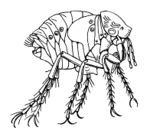Difference between revisions of "Tunga penetrans"
m (Text replace - "Category:To_Do_-_Max" to "") |
|||
| Line 1: | Line 1: | ||
| − | {{ | + | {{review}} |
| + | |||
Also known as: '''''Chigger — Jigger — Chigoe — Sand flea | Also known as: '''''Chigger — Jigger — Chigoe — Sand flea | ||
{{Taxobox | {{Taxobox | ||
| Line 32: | Line 33: | ||
See [[Flea Life Cycle|general flea life cycle]]. | See [[Flea Life Cycle|general flea life cycle]]. | ||
| − | + | ==Literature Search== | |
| − | + | [[File:CABI logo.jpg|left|90px]] | |
| − | + | ||
| + | Use these links to find recent scientific publications via CAB Abstracts (log in required unless accessing from a subscribing organisation). | ||
| + | <br><br><br> | ||
| + | [http://www.cabdirect.org/search.html?q=title:(%22Tunga+penetrans%22)+ ''Tunga penetrans'' publications] | ||
| − | |||
[[Category:Fleas]] | [[Category:Fleas]] | ||
| + | |||
| + | [[Category:Expert_Review]] | ||
Revision as of 22:45, 9 October 2010
| This article has been peer reviewed but is awaiting expert review. If you would like to help with this, please see more information about expert reviewing. |
Also known as: Chigger — Jigger — Chigoe — Sand flea
| Tunga penetrans | |
|---|---|
| Class | Insecta |
| Order | Siphonaptera |
| Family | Hectopsyllidae |
| Species | Tunga penetrans |
Hosts
Humans and Pigs are the primary hosts. Reservoir hosts include: cattle, sheep, horses, mules, rats, mice, dogs and some wild animals.
Identification
T. penetrans is a parasite of the family Hectopsyllidae. The female is around 1mm, and the male is smaller at around 0.5mm in length. The thorax is rather short, and a reddy-brown in colour.
Life Cycle
The breeding female burrow into exposed skin on the feet of mammals. They remain there for around 14 days while they develop their eggs. They enter the host using their adapted mouthparts, and the female will feed on the host body fluids.
The skin surrounding the parasite will expand and swell, leaving an opening for eggs to pass, and infect the environment.
The eggs require around 3 days to hatch, and the total life cycle requires about 12 days.
Literature Search
Use these links to find recent scientific publications via CAB Abstracts (log in required unless accessing from a subscribing organisation).
Tunga penetrans publications

